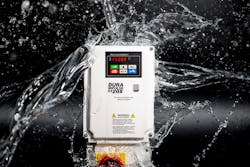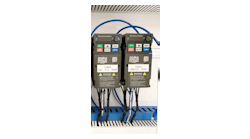Reducing complexity and cost with NEMA 4X VFDs
Variable frequency drives (VFDs) offer many other performance and monitoring advantages for industrial automation use besides the basic ability to control electric motor speeds. However, traditionally it has been necessary to install VFDs in dedicated electrical cabinets, or even a conditioned and protected electrical room. This has been problematic where there is limited space, and especially for outdoor or washdown areas.
A newer solution is available in the form of self-contained, compact and washdown-rated VFDs — which offer other multiple capabilities including AC motor speed control, a lockout point, an on-board programmable logic controller (PLC), flexible input/output (I/O) connections and more (Figure 1). VFDs provide other benefits, especially for fans and pumps in the 10 to 40 HP range often used in large manufacturing plants, such as lower startup stresses, and energy savings due to reduced operating speeds.
Designs using these VFDs lower the installation cost for many fan and pump systems, and provide additional savings in energy and maintenance costs, resulting in a quick return on investment.
Traditional installations
Typical VFDs are only rated at IP20 for dust protection, so they need to be kept in a clean and dry environment. Normally, VFDs are installed in the friendly confines of electrical rooms or enclosures, requiring conditioned and filtered air, along with proximity to PLC I/O racks and a power source. Access to these locations is usually limited to authorized personnel only, providing an additional level of safety. However, pushbuttons and local lockout switches need to be mounted near the motor — and remote from the VFD — for quick access, and this greatly increases the total installation costs, sometimes by up to 50%.
This scenario can be even more costly for motors that are located large distances away from electrical rooms. Designers are faced with the decision of installing very long cable runs from the drive to the motor, requiring expensive shielded VFD cable and line reactors to mitigate reflected wave damage to the motor. If the wiring distance exceeds recommend limits, a separate small enclosure may be necessary to mount the VFD locally, possibly with remote I/O racks to interface with the drive and controls.
These constraints are often detrimental and prevent some VFD conversions from being cost-effective enough to meet a typical two-year return on investment threshold. To address these and other issues, NEMA 4X VFDs are often the best solution.
NEMA 4X advantages
Washdown-rated VFDs (NEMA 4X or IP66) are frequently used in the food and beverage and life sciences industries because these applications require frequent washdown. However, they are suitable in many other situations, especially in remote locations, to save on equipment and installation costs.
Some modern NEMA 4X VFDs are rated for operation at temperatures up to 50°C (122°F), with no derating required. If required, the integrated external cooling fans for these VFDs are modular, inexpensive and easy to replace. While washdown-rated VFDs are typically 70% higher in cost than the equivalent IP20 version, their advantages quickly offset the increased expense by lowering the total project cost.
Power and lockout provisions
When VFDs are located in an electrical room, distances to motors in remote plant locations can reach to hundreds of feet and require specialized cables. A more economical and simple option is to install a NEMA 4X VFD mounted within a few feet of the motor. Standard power distribution wiring is used for the long run from the electrical room to the VFD, and the cable distance between the VFD and the motor is minimized.
Furthermore, the latest generation of NEMA 4X VFDs includes integrated options for local disconnection means, namely a built-in lockout hasp (Figure 2). In some cases, these devices are integrated into the VFD to minimize the footprint. Other styles provide an integral disconnect mounted at the bottom of the VFD.
Especially when VFDs/motors are located far distances from an electrical room, a local disconnect saves maintenance time walking back and forth to perform a lockout before working on equipment. It also makes for an easy, visible check to ensure the equipment power is isolated, since the disconnect is in close proximity to the equipment being serviced.
Control flexibility
For local operator controls, a conventional approach is to install/wire separate pushbuttons and lights at the motor. If a locally mounted VFD is installed, designers have the option of using the VFD keypad for starting, stopping, monitoring and changing other setpoints — providing a more comprehensive interface and saving the installation of additional pushbuttons, wiring and I/O (Figure 3).
Even if a VFD is controlled from a master PLC, the keypad functions can be used for lockout verification, or to place the VFD in manual mode and run it locally. The VFD keypad can be password protected to prevent unauthorized use.
Modern VFDs can do much more with regards to control and interface, so they can handle most applications. With I/O options of up to eight discrete inputs, four discrete outputs and several analog inputs/outputs depending on the model — a VFD can connect with local sensors and other devices — without requiring long homeruns back to a master PLC. The integrated PLC and/or PID functionality allows the VFD to execute control logic locally, unloading supervisory systems and providing a local operational capability, even when disconnected from higher-level control systems.
The VFD’s embedded PLC can be configured with ladder logic specific to its operation. Integrated PID functionality can be set up by configuring just 8 to 10 VFD parameters. With these automation capabilities, the VFD can do things like use locally wired I/O to delay startup, automatically stop given certain conditions, regulate the associated motor to maintain a given pressure or flow, or provide an equipment shutdown in case of problems. This removes the need for long wiring runs back to remote PLC racks.
Most VFDs today come standard with serial communications and/or options cards for Ethernet network communications. Installing a network connection does add cost and wiring, but is only a single connection per VFD, and it is the most comprehensive way to integrate an intelligent VFD with a supervisory PLC in a process manufacturing environment. In some cases, running a single Ethernet or communications cable to the VFD can be more cost effective than installing local pushbuttons and the associated I/O.
A common application
Consider a common application, which is a 20 HP air handling fan providing makeup air for a manufacturing plant. This unit was installed originally 20 years ago in a building and is controlled with an “across the line” starter located 200 feet away in the electrical room. This fan is typically left running all the time as it is not centrally controlled.
This rudimentary scheme is easily updated using a NEMA 4X VFD. To minimize re-wiring, a VFD is mounted on a wall near the fan motor and within the existing power wiring path. The existing motor power cable becomes the incoming power to the VFD once the motor starter in the control room is switched to a simple circuit breaker disconnect. Only a new, short power connection is needed from the output of the VFD to the motor.
Once complete, the VFD provides the means to locally lockout, adjust the speed and program any automatic conditions for the fan. Installation equipment and time are minimized, and lowering the fan speed by only 20% provides about 50% energy savings, while maintaining adequate airflow. A single network connection allows users to remotely control the VFD, and to monitor operating conditions, power consumption and diagnostics.
A modern washdown-rated VFD can provide capabilities and benefits such as this to a wide range of applications, at much lower costs than traditional solutions.
Kevin McClelion is a product engineer at AutomationDirect. Over his 20-year career he has held various power and controls engineering positions in the consumer products industry. He has led manufacturing facilities around the globe to utilize lean manufacturing concepts to ideate and deliver energy savings projects. Kevin has worked at AutomationDirect since 2019 supporting new drives and motor products. He holds a bachelor’s degree in Electrical Engineering from N.C. State University.
AutomationDirect




